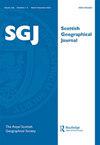内Forth河口Airth历史泥滩沉积物的放射性碳定年及19世纪农业改良对河口的影响
IF 2
4区 社会学
Q2 GEOGRAPHY
引用次数: 1
摘要
本文报道了苏格兰中部内Forth河口Higgin 's Neuk盐沼泽沉积物的沉积地层、硅藻和花粉分析以及AMS 14C测年结果。工程钻孔记录了泥滩沉积物中丰富的泥炭,这鼓励了人们在过去几个世纪里建立泥滩沉积速率的工作。然而,对泥炭进行的六项14C测定与可能是18世纪的埋藏考古结构密切相关,记录了较晚的史前和早期的历史年龄估计。人们认为化验结果是正确的。泥炭不在原处。它可能起源于18世纪末和19世纪初,人们为了农业而大量清除福斯河(River Forth)的苔藓。沉积物地层证据很重要,因为它证实了泥炭清除对河口内的影响程度。泥炭可以作为泥滩和盐沼沉积物的标志层,从中可以推导出18世纪后泥滩的增生速率。在希金斯纽克,考虑到年代控制的不确定性,这些可能非常高,在过去的大约150年里,大约是0.8厘米/年(1.2年/厘米),这一发现与北海周围的其他研究一致。本文章由计算机程序翻译,如有差异,请以英文原文为准。
Radiocarbon dating of historic mudflat sediments at Airth in the inner Forth estuary and the impact on the estuary of nineteenth century agricultural improvements
ABSTRACT The results of sediment-stratigraphic, diatom and pollen analyses, and AMS 14C dating of salt marsh sediments at Higgin’s Neuk, Airth in the inner Forth estuary in central Scotland are reported. Engineering borehole records of abundant peat within mudflat sediments encouraged work to establish rates of mudflat accretion over the last several centuries. However, six 14C assays on peat closely associated with buried archaeological structures of likely eighteenth century age record later prehistoric and early historic age-estimates. The assays are thought to be correct. The peat is not in situ. It probably originated from the well-documented, extensive late eighteenth and early nineteenth century clearance of raised mosses in the River Forth for agriculture. The sediment-stratigraphic evidence is important because it confirms the scale of the impacts of peat clearance on the inner estuary derived from contemporary documents. The peat may act as a marker horizon in mudflat and salt marsh sediments from which rates of post-eighteenth century mudflat accretion can be derived. At Higgin’s Neuk these were probably very high, given uncertainties in dating controls, around 0.8 cm/yr (1.2 yrs/cm) for the last ca. 150 years, a finding which accords with other studies around the North Sea.
求助全文
通过发布文献求助,成功后即可免费获取论文全文。
去求助
来源期刊

Scottish Geographical Journal
GEOGRAPHY-
CiteScore
1.80
自引率
20.00%
发文量
19
期刊介绍:
The Scottish Geographical Journal is the learned publication of the Royal Scottish Geographical Society and is a continuation of the Scottish Geographical Magazine, first published in 1885. The Journal was relaunched in its present format in 1999. The Journal is international in outlook and publishes scholarly articles of original research from any branch of geography and on any part of the world, while at the same time maintaining a distinctive interest in and concern with issues relating to Scotland. “The Scottish Geographical Journal mixes physical and human geography in a way that no other international journal does. It deploys a long heritage of geography in Scotland to address the most pressing issues of today."
 求助内容:
求助内容: 应助结果提醒方式:
应助结果提醒方式:


